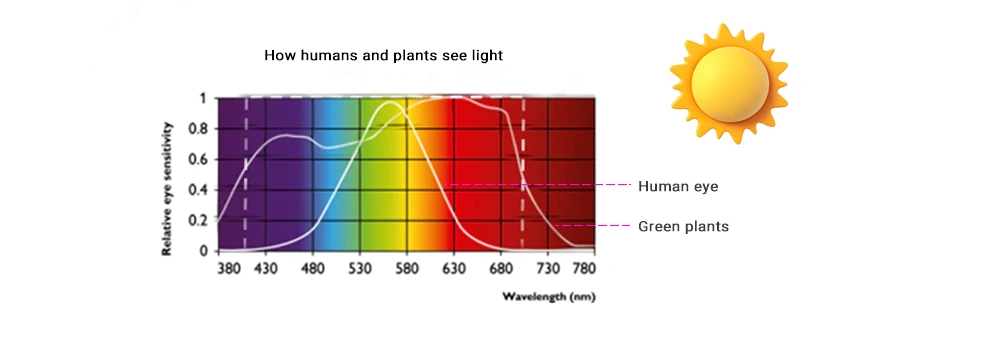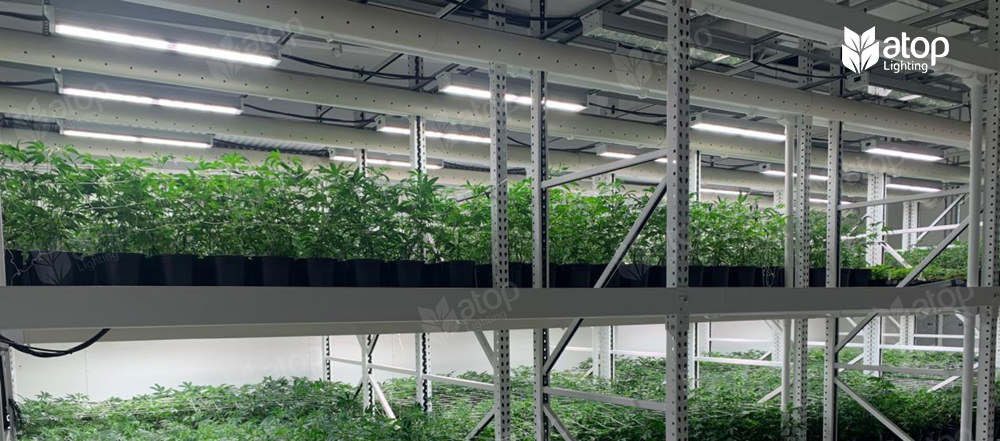Plant vs. Human Lighting: It's Not as Simple as You Think
Have you ever wondered why indoor plants require specially designed grow lights? Or perhaps you’ve considered whether regular LED lights could be used for your plants?
The truth is, humans and plants perceive and use light in very different ways. While our eyes are evolved to optimize visibility and comfort, plants have developed intricate systems to use light as their primary energy source.
In this blog, we’ll explore the key differences between how humans and plants respond to light and why using the right lighting is crucial for the health of your indoor plants.
How humans and plants see light
For humans, light is what makes vision possible. It helps us see the world in all its colors and shapes. Our eyes have special cells called rods and cones that can sense a wide range of colors. Thanks to these cells, we can tell the difference between a bright red apple and the soft green of a forest. Being able to see clearly is important for getting around, communicating, and enjoying the beauty around us.
Our eyes are most sensitive to green-yellow light, around 555 nanometers. This matches the color where sunlight is strongest on Earth.
Plants, however, experience light very differently. Instead of eyes, they have special proteins spread throughout their leaves and stems. These proteins help them "sense" light. For example, phytochromes detect red and far-red light and control when seeds sprout or flowers bloom. Cryptochromes and phototropins respond to blue light and help plants grow towards the light and open their pores. The green color we see in plants comes from chlorophyll, a pigment that absorbs mainly blue and red light and reflects green light back to our eyes.
Because humans and plants see light so differently, a light that looks bright to us might not give plants the energy they need to grow strong and healthy.

Light needs for humans
For us, light plays a vital role in regulating our circadian rhythms, the internal 24-hour clock that governs sleep-wake cycles, hormone release, and numerous other physiological processes.
The human eye functions optimally under full-spectrum light (visible light 400-700nm) with a balanced color distribution. We measure this using metrics like Color Rendering Index (CRI), where values above 90 allow us to see colors accurately, important for everything from reading to preparing meals. Our comfort also depends on color temperature, measured in Kelvins; warmer light (2700-3000K) promotes relaxation, while cooler light (4000-5000K) enhances alertness and concentration.
Exposure to bright, specifically blue-enriched light (particularly around 480nm), particularly in the morning, helps to synchronize this internal clock, promoting alertness and setting the stage for healthy sleep later on. Conversely, exposure to blue light at night can disrupt melatonin production, hindering sleep quality.
Light needs for plants
Plants rely on light as their primary energy source, using photosynthesis to convert photons into chemical energy that drives growth and reproduction. However, the light needs of plants are not measured by lumens or lux, but by PAR (Photosynthetically Active Radiation), PPFD (Photosynthetic Photon Flux Density), and DLI (Daily Light Integral).
Unlike humans, whose eyes are sensitive to a broad range of the visible spectrum, plants mainly depend on specific wavelengths: blue light (400–500 nm) and red light (600–700 nm). Blue light is crucial for vegetative growth and leaf development, while red light plays a key role in stimulating flowering and fruit production.
In addition to visible light, plants also benefit from certain wavelengths beyond the visible spectrum. Though these wavelengths do not directly drive photosynthesis, they significantly influence plant growth and health. For example, ultraviolet (UV) light, particularly UVA and UVB, in moderate amounts, can trigger the production of protective compounds like flavonoids and antioxidants, helping plants resist stressors such as pests and diseases.
Similarly, far-red light (700–760 nm) interacts with phytochrome photoreceptors to regulate processes like seed germination, stem elongation, and flowering. Far-red light is especially critical in shade-avoidance responses, enabling plants to adapt to low-light environments by promoting upward growth to access more sunlight.

Are LED grow lights safe for humans
Worried about the blue and UV light in LED grow lights and wonder whether they are safe for people? The good news is that high-quality LED grow lights are generally safe for occasional human exposure. However, there are a few things you should keep in mind to stay safe, especially if you’re around them a lot.
Blue light, which many grow lights give off, can cause eye strain if you look at it for a long time. It can also mess with your sleep if you are exposed to it too much in the evening because it can disrupt your body’s natural sleep-wake cycle. Some people even get mild headaches after being under grow lights for too long.
UV light is another thing to think about. Some powerful LED grow lights give off a small amount of UV light to better mimic natural sunlight for plants. While the UV levels are usually very low, too much exposure can still harm your skin and eyes.
If you work around grow lights for long periods, it’s a good idea to take some precautions:
- Limit the amount of time you spend directly under the lights.
- Wear long-sleeved clothing and cover as much skin as possible.
- Use protective glasses that block blue and UV light to protect your eyes.

